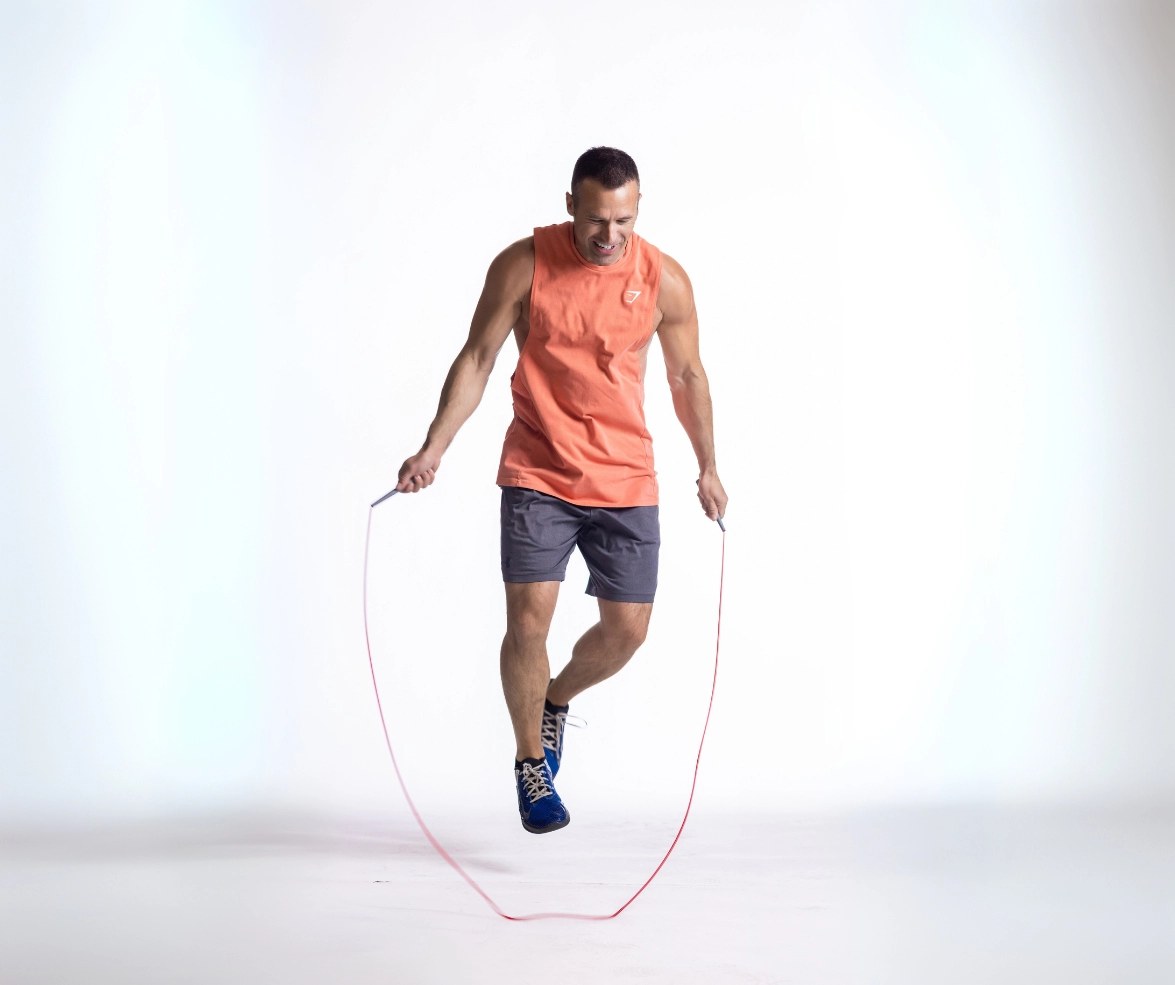Are you torn between jumping rope and jogging for your cardio fix? Both are fantastic ways to boost your fitness, but choosing the right one for your goals, lifestyle, and body can feel overwhelming. As fitness enthusiasts ourselves, we get it—finding the perfect workout is key to staying motivated and seeing results. At PVCJumpRope.com, we’ve helped countless people discover the power of a great cardio routine. In this guide, we’ll break down the benefits, calorie burn, and practicality of jumping rope vs jogging, so you can decide which is your ultimate fitness match. Let’s jump in!
Physical and Health Benefits Comparison of Jumping Rope vs Jogging
Both jumping rope and jogging are excellent cardiovascular exercises that improve overall health, but they offer unique benefits in terms of muscular strength, endurance, bone density, and weight management. Understanding these differences can help you choose the best workout for your fitness goals.
Cardiovascular Health Improvements
Jumping rope and jogging both significantly boost cardiovascular fitness by increasing heart rate and improving circulation. Regular activity with either reduces the risk of heart disease, lowers blood pressure, and enhances lung capacity.
- Jumping rope demands rapid, continuous movement, providing an intense cardiovascular challenge in short periods.
- Jogging offers steady, moderate cardio benefits that improve aerobic endurance over longer sessions.
Both exercises effectively improve heart health, but jumping rope achieves higher intensity in less time, perfect for those seeking efficient fat-burning workouts.
Impact on Muscular Strength and Endurance
Jumping rope actively engages more muscle groups, especially in the lower legs, calves, forearms, and shoulders, thanks to the coordination required to swing the rope and maintain rhythm.
- This enhances muscular endurance and strength, promoting lean muscle development.
- Jogging primarily targets lower body muscles such as the quadriceps, hamstrings, calves, and glutes, promoting endurance but less upper body involvement.
If your goal includes building full-body endurance alongside cardio fitness, jumping rope offers a distinct advantage.
Effect on Bone Density and Joint Health
Jumping rope is a weight-bearing exercise that sends small impact forces through bones and joints, stimulating bone density improvements. It can help reduce osteoporosis risk when performed properly on suitable surfaces.
Conversely, jogging, depending on pace and terrain, can exert higher forces on joints like the knees and ankles, leading to potential wear over time, especially for those with existing joint issues.
- Jump rope workouts with controlled impact can be a lower joint-stress option compared to frequent jogging.
- Proper technique and surface choice are key to minimizing injury in both exercises.
Weight Loss and Calorie Burning Comparison
Both jogging and jumping rope are effective for weight loss, but their calorie-burning profiles differ by intensity and duration.
- A 30-minute jogging session can burn roughly 240 to 370 calories depending on body weight.
- Jumping rope burns around 300 to 450 calories in the same time frame, often making it the more efficient fat-burning workout.
Both exercises support sustained calorie deficits essential for weight loss, but jumping rope’s higher intensity allows for shorter workout times to achieve similar results.
Choosing between jumping rope and jogging depends largely on personal preferences, fitness levels, and specific health goals. Both improve cardiovascular health, promote muscular endurance, support bone strength, and aid weight loss — making them valuable cardio options for anyone seeking a healthy, active lifestyle.
Calorie Burn Jumping Rope vs Jogging
Average Calories Burned for Different Body Weights
When it comes to burning calories, jumping rope and jogging are both effective, but they differ in intensity and calorie output depending on your body weight. Here’s a quick look at how many calories you can expect to burn:
| Body Weight (lbs) | Jumping Rope (10 min) | Jogging (10 min) | Jumping Rope (30 min) | Jogging (30 min) |
|---|---|---|---|---|
| 125 | ~130 calories | ~100 calories | ~390 calories | ~300 calories |
| 155 | ~170 calories | ~125 calories | ~510 calories | ~375 calories |
| 185 | ~200 calories | ~150 calories | ~600 calories | ~450 calories |
Jumping rope burns roughly 25-30% more calories than jogging in the same time frame, thanks to its higher intensity.
Factors Affecting Calorie Burn
Calorie burn isn’t just about the exercise itself. Several factors can influence how many calories you actually burn:
- Body weight and composition: Heavier people burn more calories doing the same exercise.
- Workout intensity: Faster rope skipping or sprint jogging amps up calorie burn.
- Duration: Longer workouts result in more calories burned, but maintaining high intensity is key.
- Fitness level: Beginners might burn fewer calories initially but improve over time.
- Technique: Proper form maximizes efficiency and calorie burn.
Which Is Better for Fat Burning
Both jumping rope and jogging are excellent for burning fat, but jumping rope tends to be more efficient due to the combination of cardio and strength components in one workout. You get your heart rate up quickly, and the constant movement engages multiple muscle groups.
- Jumping rope fits well into interval training (HIIT) which is proven to boost metabolism and continue burning calories after your workout.
- Jogging is often steady-state cardio, great for endurance and burning fat consistently over longer periods.
Bottom Line
If your goal is maximum calorie burn in less time, jumping rope generally edges out jogging. But if you prefer a lower-impact, steady workout or longer sessions, jogging might be the better fit. Both can be adjusted to your fitness level and combined effectively for fat loss and cardiovascular health.
Convenience and Accessibility of Jumping Rope vs Jogging
When deciding between jumping rope and jogging, convenience and accessibility play a big role, especially for those balancing busy schedules or limited space.
Equipment Needs and Space Requirements
- Jumping rope requires minimal gear — just a quality jump rope, like those from PVCJumpRope.com, and some open space to swing the rope safely. You don’t need fancy shoes but having good supportive sneakers helps.
- Jogging demands a pair of reliable running shoes to protect your feet and joints. Plus, you need access to safe outdoor routes or a treadmill if indoors.
In terms of space, jump rope workouts can easily fit indoors, requiring only about a 6×6 foot area with decent ceiling height. Jogging, on the other hand, typically takes place outdoors or needs a treadmill at home or gym.
Weather and Workout Flexibility
- Jumping rope is excellent for all-weather workouts since you can do it indoors. Rain, snow, or extreme heat won’t stop your session.
- Jogging outdoors is weather dependent. Cold, rain, or icy conditions can force cancellations or require specialized gear.
Portability and Cost Savings
- Jump ropes are ultra-portable and affordable. You can toss a jump rope in your bag and work out anywhere, whether it’s a hotel room, park, or office.
- Jogging is free if you have a safe route, but to jog anywhere, you still need good shoes and sometimes additional gear like weather-appropriate clothing. Plus, access to suitable running areas isn’t always convenient for everyone.
of Convenience and Accessibility
| Factor | Jumping Rope | Jogging |
|---|---|---|
| Equipment | Jump rope (inexpensive) | Running shoes (higher cost) |
| Space Needed | Small indoor or outdoor area | Outdoor trails or treadmill |
| Weather Impact | Low, ideal indoors | High, outdoors depends |
| Portability | Very portable | Limited to outdoor access |
| Cost | Low initial investment | Moderate (shoes, gear) |
In short, jumping rope offers greater convenience with minimal equipment, flexible indoor/outdoor options, and portability at a low cost. Jogging requires more space, favorable weather, and specialized shoes, which can make it less accessible for some. This makes jump rope workouts a solid choice for busy Americans who need quick, effective cardio without the hassle.
Impact on Joints and Injury Risks Jumping Rope vs Jogging
When comparing jumping rope vs jogging in terms of joint stress and injury risks, there are important differences to consider, especially if you’re managing past injuries, new to exercise, or concerned about long-term joint health.
Joint Stress Analysis Jogging vs Jumping Rope
- Jogging tends to place significant repetitive impact on the knees, hips, and ankles. Each foot strike transmits force through these joints, which can aggravate conditions like arthritis or lead to overuse injuries over time.
- Jumping rope, while also a high-impact activity, usually involves shorter, controlled jumps that put less strain on your joints because your landing is softer and more evenly distributed. This can be easier on your knees and lower back compared to jogging.
- However, jumping rope does require good ankle stability and can stress the Achilles tendon if done improperly or on hard surfaces.
Common Injuries and Prevention Tips
Jogging injuries often include:
- Runner’s knee
- Shin splints
- Plantar fasciitis
- IT band syndrome
Jumping rope injuries commonly involve:
- Ankle sprains
- Achilles tendon irritation
- Calf strains
Prevent Injuries With These Tips:
- Always warm up well before either workout.
- Use proper footwear: cushioned running shoes for jogging, and shock-absorbing surfaces or mats for jumping rope.
- Start slowly to build endurance and adjust intensity gradually.
- Focus on good form—keep landings soft and knees slightly bent.
- Incorporate strength and flexibility training to support joints and muscles.
Suitable Candidates by Age Injury History and Fitness Level
- Jumping rope is typically better suited for those with stronger ankles and no major joint issues. It’s great for younger adults or anyone with good baseline fitness who wants a portable, high-intensity workout.
- Jogging is more accessible for beginners because it requires less coordination, but if you have knee or hip problems, it might increase joint pain.
- For older adults or those with arthritis, low-impact alternatives might be better than either exercise, though gentle jogging on soft trails or short jump rope sessions can work if done carefully.
- Always check with a healthcare provider if you have a history of joint injuries or chronic issues before starting a new cardio routine.
Understanding how both activities affect joints and injury risk helps you choose the best workout that fits your body’s needs while minimizing setbacks. Whether you pick jumping rope or jogging, maintaining proper form and listening to your body are key to staying active safely.
Skill Level and Learning Curve Jumping Rope vs Jogging
When it comes to starting jogging, most people find it straightforward—just put on shoes and hit the pavement. Jogging requires minimal skill or coordination, making it accessible to nearly all fitness levels. You can begin at a slow pace and gradually increase your distance or speed, which makes jogging easy to adapt as you improve.
Jumping rope, on the other hand, requires more initial coordination and rhythm. It’s a skill-based workout where you need to time your jumps with the rope’s movement. Beginners often face challenges like tripping or uneven pacing early on. However, with a quality jump rope like those found at PVCJumpRope.com and consistent practice, most people can pick up the basics fairly quickly.
Key Points on Skill and Coordination for Jumping Rope
- Coordination requirement: Jump rope demands good hand-foot coordination and timing.
- Learning curve: Beginners might take a few sessions to jump smoothly without interruptions.
- Balance and rhythm: Developing these improves endurance and workout fluidity.
Progression and Workout Variety
Once you get the hang of jump roping, the progression potential is impressive:
- From basic two-foot jumps to advanced techniques like double-unders, crisscross, or high knees.
- Variety keeps workouts challenging and prevents boredom.
- Jump rope easily adjusts intensity—from slow-paced endurance jumps to high-intensity interval training (HIIT).
Meanwhile, jogging progression generally involves extending distance or speed. While it offers consistency, it has less built-in variety unless mixed with sprints or trail runs.
- Jogging is the easiest to start with the lowest learning curve.
- Jumping rope offers higher skill development, with coordination playing a key role.
- Both offer solid progression paths, but jump rope shines in workout variety and skill mastery, making it more engaging long-term.
If you’re interested in mastering jump rope techniques or expanding workout variety, consider checking out our jump rope exercise routine for tips to speed up your progress.
Time Efficiency and Workout Intensity Jumping Rope vs Jogging
When it comes to time efficiency and workout intensity, jumping rope and jogging offer different advantages that fit various busy lifestyles.
Faster Results with Jumping Rope
Jumping rope is known for delivering quick fitness benefits in a shorter time. Because it’s a high-intensity workout, you can burn a significant amount of calories in just 10 to 15 minutes. This makes it ideal for people who want fast results without spending a lot of time exercising. Plus, jump rope workouts can easily be turned into HIIT (high-intensity interval training) sessions, alternating bursts of fast jumps with short rest periods, which boosts cardiovascular health and fat burning even more efficiently.
Steady Jogging for Consistent Endurance Building
Jogging, on the other hand, is more of a steady-state cardio exercise. It’s less intense per minute but easier to sustain longer, helping build endurance over time. Jogging is perfect for those who prefer a moderate-intensity workout that can last 30 minutes or more, supporting cardiovascular improvements and overall stamina.
Which Works Better for Busy Schedules
- Jump Rope: Best for people with limited time who want a quick, effective workout. A 15-minute jump rope HIIT session can replace longer cardio sessions and still improve cardiovascular health, muscular endurance, and calorie burning.
- Jogging: Better suited for those who enjoy longer, steady workouts and can dedicate 30 minutes or more. It fits well with people who like a regular routine without too much impact or technical skill required.
If you’re short on time but want high-intensity fat burning and fitness benefits, jumping rope is the efficient choice. For those with a bit more time who want steady endurance improvements, jogging fits well. Both can be adjusted to your schedule, but jump rope offers more options for quick, intense workouts perfect for busy Americans looking to maximize their workout time.
Psychological and Motivational Factors Jumping Rope vs Jogging

When it comes to staying motivated with cardio workouts, both jumping rope and jogging offer unique advantages and challenges.
Enjoyment and Boredom Factors
- Jumping rope can feel more engaging because it requires focus and coordination. The fast pace and skill involved often make the workout feel like a fun challenge rather than a chore. However, some might find it repetitive after a while.
- Jogging tends to be more repetitive but can be relaxing, especially when done outdoors in nature. The steady rhythm helps many clear their minds, but others might get bored quickly, especially if running on a treadmill or the same loop.
Community vs Solo Workouts
- Jogging has a strong community presence. Running clubs and group jogs are common and provide social motivation, accountability, and fun competition.
- Jumping rope is mostly a solo activity but can be done in group classes or challenges. It’s great for those who prefer quick, solo workouts but want to track personal progress or share milestones online.
Motivation to Stay Consistent
- Both workouts require self-discipline, but jump rope workouts are often shorter, making it easier to fit into busy schedules, which supports consistency.
- Jogging can become a habit with routine and social support but demands more time commitment.
Key points to stay consistent:
- Set clear, achievable goals, whether it’s improving jump rope time or increasing jogging distance.
- Mix up your routine to combat boredom — alternate jump rope sessions with easy jogs.
- Join a local running group or online jump rope community to keep motivation high.
choosing between jumping rope or jogging can depend on your personal preference for enjoyment, social interaction, and how you maintain motivation over time. Both have proven psychological benefits for mental health, focus, and mood improvement.
Who Should Choose Jumping Rope Benefits and Ideal Users

Jumping rope is a highly effective cardio workout for beginners and experienced athletes alike. It’s especially great if you want a portable, efficient exercise that fits into a busy lifestyle. Here’s who can benefit most from choosing jumping rope over jogging or other workouts:
- Busy individuals with limited time who want a fast, intense workout that improves cardiovascular health and muscular endurance.
- Fitness beginners looking for an easy way to build coordination and stamina without needing a lot of space or expensive equipment.
- Athletes and boxers focusing on agility and footwork will find jumping rope enhances speed and balance. (Learn why boxers jump rope here.)
- Those recovering from some injuries (with approval from a health professional) because it’s a lower impact option versus running, especially when proper rope length and technique are used.
- People living in areas where outdoor jogging isn’t feasible year-round due to weather or safety concerns.
- Anyone wanting a calorie-burning exercise that improves bone density and joint health without the repetitive pounding of running.
Role of Quality Equipment from PVCJumpRope com
Using a high-quality jump rope is crucial to maximize the benefits and minimize injury risks. Cheap or improper ropes can disrupt your rhythm, cause tripping, or add unnecessary strain to joints. That’s why choosing a trusted manufacturer like PVCJumpRope.com makes a real difference.
- Their ropes are designed for durability and smooth rotation to ensure fluid movement.
- They offer customizable lengths to fit all heights, improving workout comfort and effectiveness. See how to measure the right jump rope length here.
- Lightweight yet sturdy materials help maintain workout intensity without fatigue.
- Investing in quality ropes means your jump rope workouts stay consistent, enjoyable, and injury-free, making it easier to stick with your fitness goals.
jumping rope suits a wide range of users from beginners to seasoned fitness enthusiasts—especially those valuing flexibility, efficiency, and joint-friendly cardio. Pairing this with reliable equipment like you find at PVCJumpRope.com sets you up for the best results.
Who Should Choose Jogging Best Cardio Exercise for Weight Loss and Health

Jogging is a great choice for many people, especially those looking for a low-impact cardio exercise that improves endurance, cardiovascular health, and burns calories steadily. It’s ideal if you:
- Prefer outdoor workouts with plenty of fresh air and varied terrain.
- Want a straightforward exercise that requires minimal learning or equipment.
- Are aiming for weight loss or to maintain a healthy heart over the long term.
- Like a rhythmic pace that’s easier to sustain for longer periods.
- Have access to safe running spaces like parks, trails, or tracks.
Ideal User Profiles for Jogging
- Beginners or casual exercisers who want to start building fitness gradually.
- People who enjoy a solo or social workout—jogging can easily be done with friends or running groups.
- Individuals with moderate joint health who can tolerate repetitive motion without pain.
- Those focusing on steady fat burning and improving mental health benefits linked to aerobic exercise.
- Runners training for races or events, as jogging builds solid aerobic fitness.
Tips to Get Started Safely With Jogging
Jumping into jogging without preparation can lead to injuries or frustration. Here are some key tips to help you get going safely:
- Invest in good running shoes designed for your foot type and terrain to reduce injury risk.
- Start with a mix of walking and jogging intervals; don’t rush into continuous running.
- Warm up with dynamic stretches and cool down to reduce muscle tightness.
- Pay attention to your body—stop if you feel pain or excessive fatigue.
- Gradually increase distance and pace over weeks to build endurance safely.
- Stay hydrated and choose appropriate clothing for weather conditions.
- Consider cross-training or strength work to support joint stability.
Jogging offers a straightforward, effective way to stay fit if you want a reliable path to improved health and consistent calorie burn. With the right gear and cautious approach, it’s accessible for most fitness levels and lifestyles.
Combining Jumping Rope and Jogging for Maximum Fitness Results
Mixing jumping rope and jogging is one of the smartest ways to boost your overall fitness. Both exercises complement each other well, targeting different aspects of cardiovascular health, muscular endurance, and calorie burn. When combined, you get a full-body workout that’s efficient, varied, and fun—perfect for people in the U.S. who want to stay active without spending hours training.
Why Combine Jump Rope and Jogging
- Balanced cardio training: Jogging provides a steady-state aerobic workout, great for building endurance, while jumping rope adds bursts of high-intensity cardio improving your speed and agility.
- Muscle variety: Jogging mainly works your lower body, while jumping rope engages shoulders, arms, and core more actively.
- Preventing boredom and plateaus: Switching between these two keeps your workouts fresh and challenges your body in new ways.
- Joint health management: Jogging is lower impact compared to jumping rope, so alternating can reduce overuse injuries.
Sample Workout Routines Integrating Jump Rope and Jogging
Here are a couple of routine ideas that blend jump rope workouts for beginners with jogging for steady cardio:
Routine 1 – Interval Combo (30 minutes total)
- Warm-up: 5 minutes light jogging
- Jump rope intervals: 1 minute jumping rope / 2 minutes jogging (repeat 6 times)
- Cool down: 5 minutes walking/stretching
This routine uses jump rope bursts for high-intensity intervals, helping to burn more calories and improve cardiovascular efficiency faster than jogging alone.
Routine 2 – Steady Jog with Jump Rope Finisher (40 minutes total)
- Steady jog: 30 minutes at a comfortable pace
- Jump rope: 5 sets of 1-minute rounds with 30 seconds rest
- Cool down: 5 minutes walking/stretching
This workout focuses on building endurance through jogging and ends with a jump rope finisher to elevate heart rate and improve coordination.
Tips for Combining Both Workouts Successfully
- Start slow: If new to either exercise, gradually increase duration to avoid injury.
- Use quality equipment: A good PVC jump rope from trusted U.S. manufacturers ensures durability and helps with smooth skipping.
- Listen to your body: Alternate days or combine them in a single session based on how you feel and your fitness goals.
- Mix intensity levels: Combine steady jogging days with jump rope HIIT sessions for optimal fat burning and endurance.
Final Thoughts
Combining jumping rope with jogging lets you maximize calorie burn, improve cardiovascular fitness, and build muscular endurance efficiently. Especially in the U.S., where busy schedules demand flexible workouts, this blend offers portable cardio workouts that adapt to weather conditions and personal preferences. Try integrating both into your weekly routine and enjoy a balanced, effective path to better health.



